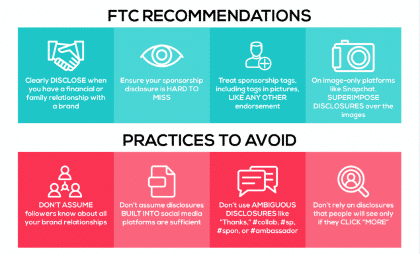
The 2 Rules of Sponsored Content You’re Not Allowed to Forget
Sponsored content, sometimes described as “native advertising,” is a controversial topic in the world of content marketing.
While we’ve covered the great content quantity vs. content quality debate many times, I also wanted to cover an area where I see a lot of brands getting into some trouble.
The reasons for this controversy are clear: Sponsored content is often advertising masquerading as pure editorial content, which can be easily misconstrued by the audience.
Content published on the web by a known author recommending a product should be clearly labeled as a paid endorsement if there is any relationship between the influencer and the brand.
Until recently, there has been very little regulation over sponsored content, which has only added to the confusion from all sides. Recently, the rules have been tightened up, making it easier for everyone to know what is right and wrong.
When managed well, sponsored content can be beneficial for the sponsor, the publisher, and the audience. But it’s important for sponsors and publishers alike to stick to two main rules.
Quick Takeaways:
- Sponsored content is an increasingly popular way for brands to advertise and publishers to generate income.
- It’s important to understand advertising disclosure rules so you stay out of trouble or a PR disaster.
- Sponsored content must be presented carefully to avoid losing the trust of your audience.
- Publishers and brands should work together on conforming to all required standards.
What Is Sponsored Content?
But before we get into exactly what those rules are, let’s define exactly what we’re talking about here.
Sponsored content is promotional content that is paid for by a sponsor and published on someone else’s website, blog, social media account, or other platform.
In some cases, the content may be provided by the sponsor. Other times the sponsor may leave the publisher to create it, with stipulations on the general content topic, included keywords, and links.
Examples of sponsored content might include:
- A photograph of an influencer wearing an item of clothing provided and paid for by a brand.
- A blog post comparing different VPN services that is sponsored by a particular VPN provider.
- A video on YouTube with a message at the start that a particular advertiser sponsored it.
Ideally, it should be clear to the reader when content is sponsored, and the content should fit in with the rest of the content on the publisher site and provide some kind of value to the audience.
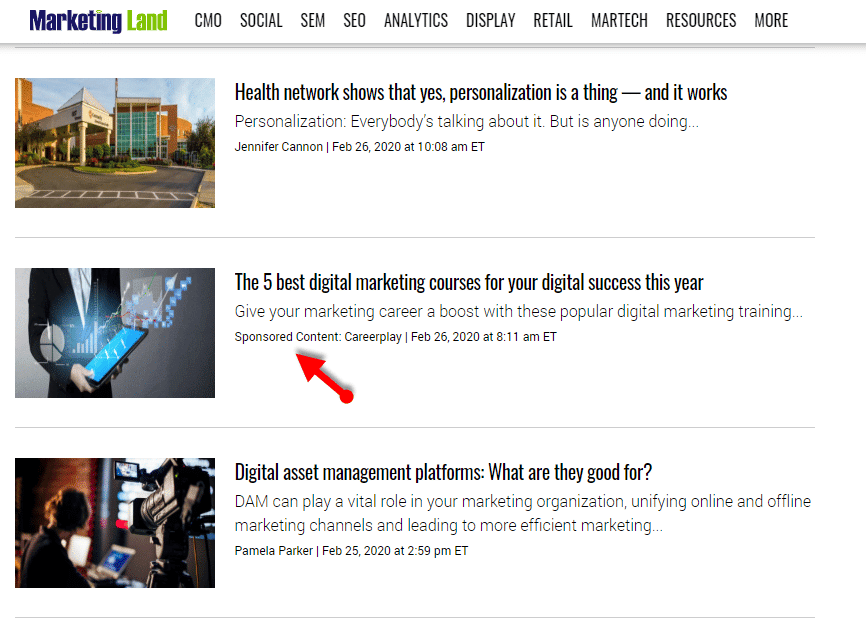
However, this does not always happen. Publishers not disclosing a financial relationship with a sponsor or publishing content that does not align with their audience can quickly erode the trust they have built with their audience and even result in legal issues.
What’s the Difference Between Sponsored Content and Native Advertising?
Native advertising and sponsored content are used interchangeably, but there is a subtle difference.
Native advertising looks somewhat similar to a traditional ad, and most users will be able to immediately identify it as such. Some examples of native advertising include:
- Sponsored listings at the top of search results
- Promoted listings on shopping websites like eBay or Amazon
- Ads in social media feeds on platforms like Facebook and Instagram
- Recommendation widgets at the end of blog posts
Most native advertising is not a form of content marketing. Just look at my definition of content marketing for more clarification!
You can’t build an audience with native advertising, and the ads rarely provide value in the form of information or entertainment that high-quality content does.
On the other hand, sponsored content as described in the previous examples does not necessarily look like an ad. While it may — and should! — be disclosed as such, you must be able to remove the reference to the sponsor without reducing the value of the content to the audience.
Check out this video of mine from a few years ago talking about the important differences between native ads, branded content, and content marketing:
The Two Rules of Sponsored Content
For both publishers and sponsors to use sponsored content in an ethical way that’s beneficial to all, it’s important to follow these two basic rules:
- Create great content.
- Always provide full disclosure.
Why are these rules so important? Well, the No. 1 rule of content marketing is to create great content. This rule shouldn’t change just because the content is sponsored.
Remember, as a content marketer you have a responsibility to your audience to provide value. Content that doesn’t give anything back to your audience won’t be engaging, won’t convert, and essentially won’t offer anything to the advertiser. In other words, it’s a waste of time and money.
Even worse, if you publish low-quality content on your site just because you’re paid to do so, you’ll be compromising your integrity as a publisher and losing your authenticity. Your audience will only put up with so many pieces of bad sponsored content before they lose trust in you entirely. Don’t risk losing your audience by publishing bad content, whether you’re getting paid for it or not.
So let’s look at the second rule: Just why is it so important to provide full disclosure?
Well, for one thing, it’s the law. The Federal Trade Commission (FTC) has specific guidance for online publishers and is very clear that any connection to a brand must be disclosed when publishing content that can be considered as an endorsement for that brand.
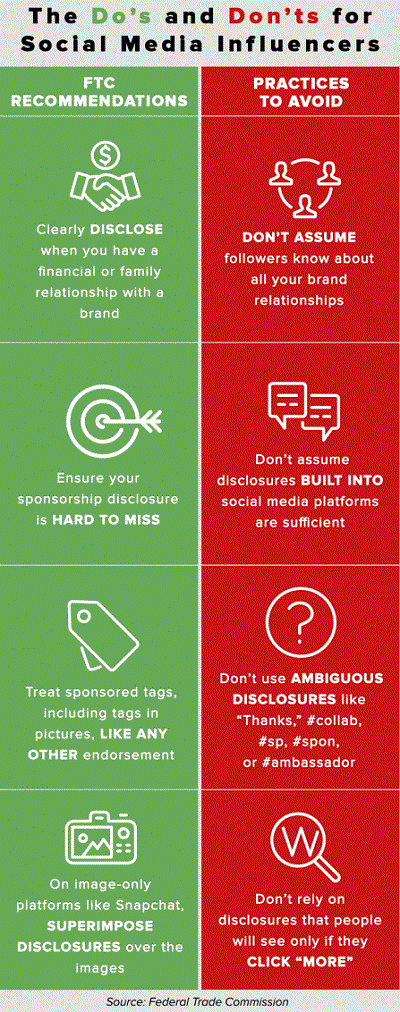
Secondly, being transparent with your audience that content is sponsored from the start shows that you respect them and that you’re not trying to pull the wool over their eyes for a quick buck.
Brand Journalism and Disclosure
I keep going back to a video where SAP’s former CMO Jonathan Becher (@jbecher), discussed “brand journalism, disclosure, and sponsored content” with one of the leading independent analysts in the IT industry, Jon Reed (@JonERP).
I was thrilled that they discussed the launch of our Business Innovation website where I was the chief editor at the time.
But I was more excited about the open discussion they had around the importance of full disclosure, about the need for brands to get involved in the conversation, to become like publishers and to reach out to new audiences with quality content.
Here’s the video if you want to get right down to it first:
Jon and Jonathan spoke about a few very specific SAP examples. So I will summarize their points at a more generic or abstract level since I believe they apply to any brand or marketer or content contributor. The key messages were:
- A strong brand will have active and socially engaged employees.
- Contributors on any site should fully disclose their employer and any paid arrangements.
- Companies are beginning to realize that in order to reach a larger audience, they need to think like publishers.
- Leading companies are creating content destinations that provide high-valuable content to potential customers. Disclosure is an important issue for these sites as well.
As additional background, I wrote this article called “Will Content Marketing Destroy Social Media” based on a Tweet during the Superbowl from a different analyst but on this same topic of sponsored content. With 47 comments, it was one of the most active discussions that have taken place here at MIG.
Jon Reed framed the discussion by outlining that there is a big shift in media. There is brand journalism. Brands often sponsor content, alongside advertisements and this raises issues of disclosure, transparency and authenticity.
Jon mentioned that there is some criticism of brands who produce great content as members of an active community and then also produce sponsored content which “has a whole different vibe.”
According to former SAP CMO Jonathan Becher, everyone is struggling with the question of what is our message vs. what is someone else’s message. “The lines are blurring,” he says. Everyone agrees that brand employees should be part of the conversation and interact with the community.
But should brands censor their own “promotional” messages or certain voices? Jon Reed said “we’re all being paid by someone.” And so they both agreed that employees and other evangelists should all be part of the conversation as long as they achieve this full disclosure: explain who is paying you and for what?
But then Jonathan explained that brands are always looking to achieve greater reach. To achieve that, to participate in new conversations on other communities, brands need to reach out to third-party channels.
When a brand participates on a third-party site, there should be full disclosure that you are a brand employee. And if the space is paid for, that should also be disclosed. Bottom line is that authors of content should disclose their employer and should disclose if they are getting paid to write an article.
The pair also discussed the need for brands to become like publishers and magazine editors and develop sites that “earn eyeballs” through use of thought leadership, featured content and news. These sites should set the bar high for the quality of the content. And they need to be meticulous about disclosing transparent relationships and presenting a balanced view.
How We Do Sponsored Content At Marketing Insider Group
For some of our more mature clients who are looking for guaranteed traffic to the content we create for them, we use contextual advertising to natively promote our client’s content.
But we don’t do this blindly. Of course we follow the 2 rules mentioned above (create great content, always provide full disclosure).
We use native platforms like Outbrain and Taboola to serve up “You might also like” or “From around the web” suggestions. But through the use of AI-driven algorithms, we only show this content to audiences who have engaged in similar content before. We only show it to them on platforms where they are likely to engage with the content.
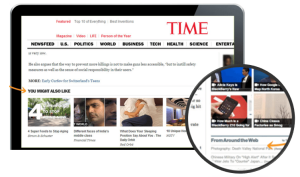
And most importantly, when a reader clicks on the ad, they come and read the article on our clients website. So we are using paid media to deliver “owned media” visitors.
And because of the contextual nature of the ad, we deliver extremely high click through rates (+2% vs. the average 0.05% for digital banner ads) at extremely low costs per click ( less than $0.20 vs. $2.00 CPCs for the industry).
How Sponsored Content Can Benefit All
It’s becoming increasingly difficult for brands to charge for premium content when consumers expect it to be free.
Sponsored content is an alternative way for publishers to generate revenue and pay their creators to generate more high-quality content.
Sponsors benefit from having their brand and products introduced to a wider audience. That audience can also benefit, provided the content is of value to them and the brand sponsor provides products and services that may be useful to them.
When produced with care and integrity, sponsored content brings value to all parties. But it’s critical to keep the two central rules in mind at all times: Create great content. Always provide full disclosure.
And if you’re interested in learning more about getting and promoting amazing weekly blog content from us, check out our Content Builder Service PRO level.

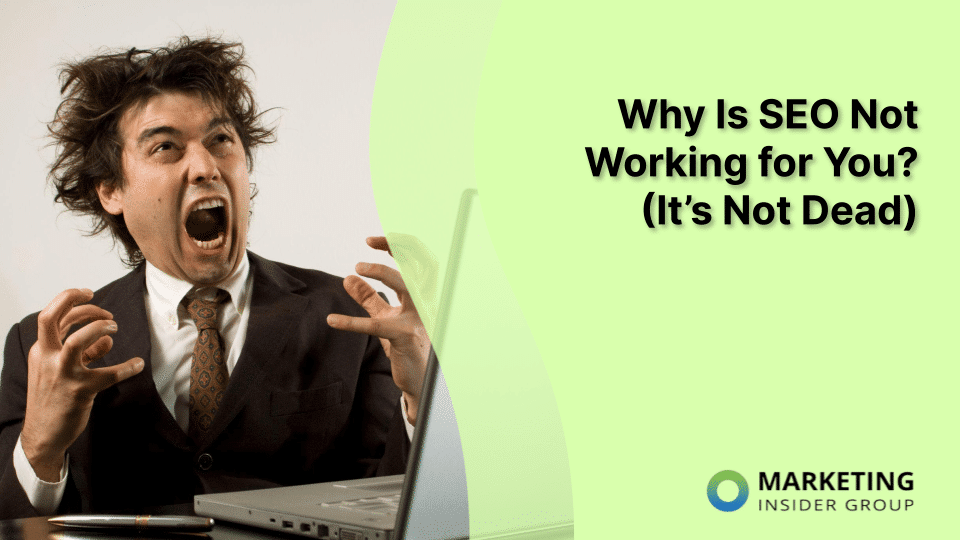
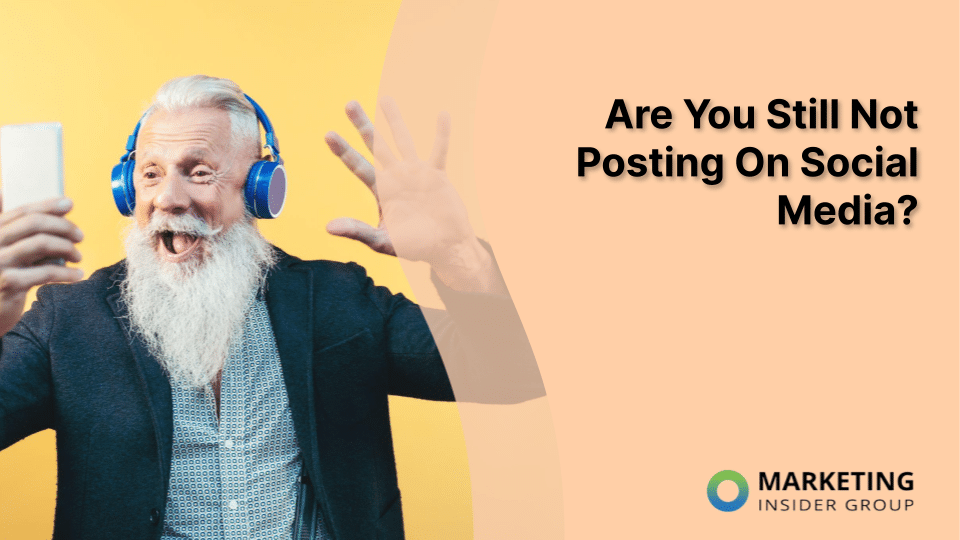
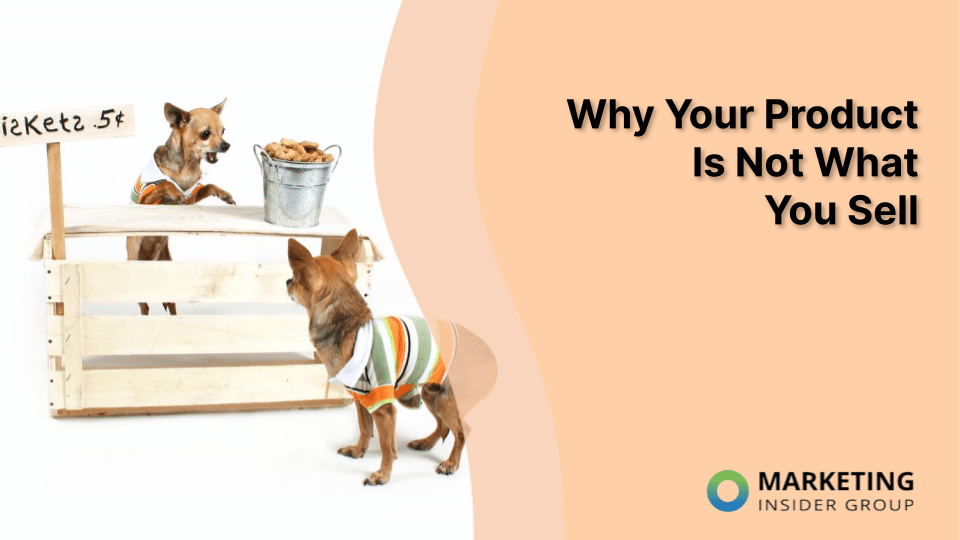

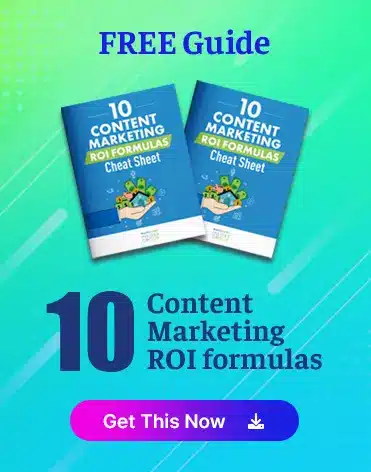

Hi Michael,
Great post here. I fully agree that editorial content alignment needs to be quality content that helps the end user! I also like that you separated out editorial and native advertising. I just yesterday read a really good post from AdAge about how brands can’t always produce content on the scale of publisher, and they shouldn’t try to either. (https://adage.com/article/digitalnext/brands-stop-publishers/244059/)
Thanks for the great post (as always)
-Ben
Thanks so much Ben! I will definitely check it out!
Hi Michael,
Well written mate. I love the #2 point. Writing and disclosing that is a MUST for any sponsored post. I mean the etiquette should be there as well right?
Anyway, great write and thanks for sharing this. Shared on Triberr.
Reginald
Thanks Reginald and always appreciate the Triberr shares.
I agree! when creating a content you must be a good listener to your audience needed. Thanks for sharing this blog post.
Totally agree on the importance of Rule #2. No one wants to find out at the end of reading something that it was sponsored content, not objective editorial.
Thanks Erika. Both rules are important but this one takes priority.
Michael,
As you point out, sponsored content has been around a long time. Now that content marketing has become mainstream, I believe we are going to see more sponsored content in digital channels.
The winning formula for sponsored content (which you covered) is:
1) full disclosure from the content channel
2) valuable/relevant content
3) 3 winners: the end user, the sponsor, the channel.
I believe we are going to see a lot more sponsored content in 2014. That’s my early prediction for next year.
Thanks for covering this topic.
– Bernie Borges
Thanks Bernie, you hit on exactly my main point at the panel I was on at #CMWorld: the publishing industry needs to find a way to sustain itself. I do believe sponsored content can be good for the reader, the sponsor and the publisher. As long as we hit #1 and #2 of full disclosure and great content.
Appreciate your support and it was great seeing you.
Important to insist on a ‘nofollow’ link when publishing advertorials for others, otherwise you risk a google slap!
Good point Duncan. Brands beware of the Google slap!
Great post-Remembering the ‘rules’ is very important. I see many posts that highly appear to be sponsored and no disclosure!
I do think it’s as simple as that!
Great debate Michael. Thanks for sharing. I’m including this trend in my content marketing 2014 summit webcast via smart insights (brighttalk) on tuesday and will examine the Zurich/Guardian partnership which seems to me to tick all the boxes in your governance chart https://www.theguardian.com/money/2013/feb/15/about-life-navigator
Thanks Stephen. I’m going to check that one out.
Seems everybody is going for rule #2, that’s the same thing I’m about to say too. Thanks for sharing.
My experience has been that all content providers insist on a “do follow” link. It’s a catch 22. Either you get no sponsored posts or Google slaps you down. Any ideas for a solution?
That is why we mainly only do guest posting (topic for another post) or the paid contextual ads I mention in the bottom of the post.
I think most people do sponsored posts for their egos / “branding” anyway so the links don’t matter.